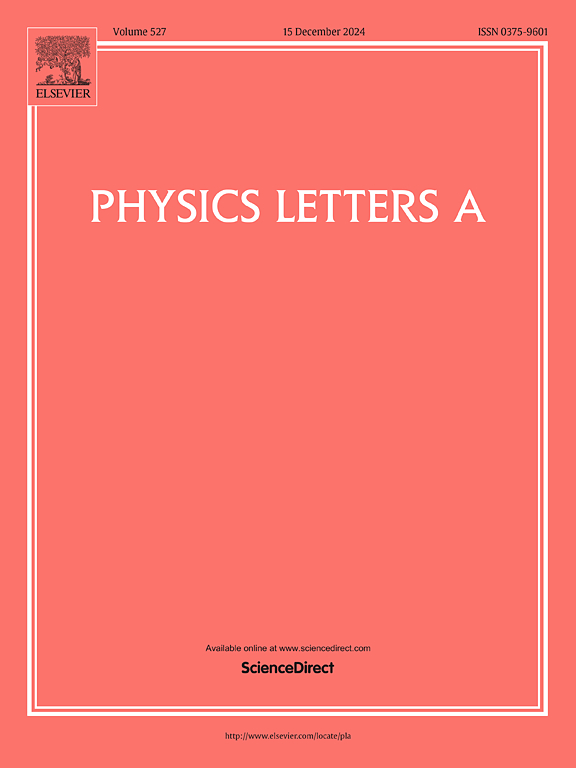CaB11−: A unique four-ring conjugated dual aromatic system
IF 2.3
3区 物理与天体物理
Q2 PHYSICS, MULTIDISCIPLINARY
引用次数: 0
Abstract
At the B3LYP/6–311G(d) level, we obtained the ground state structures of CaBn0/− (n = 2–12). Observing the evolution characteristics of these structures, we found that the transition from two-dimensional to three-dimensional structures occurs when the number of boron atoms equals 6 (for the neutral system) and 7 (for the anionic system). For the three-dimensional structure, the Ca atom is always positioned above the plane or quasi-plane formed by the boron atoms (at the vertex position), similar to an umbrella-like structure. In most cases, the neutral and anionic structures with the same number of boron atoms are consistent. The only exceptions are CaB6− and CaB11−, where the neutral structure is three-dimensional, but upon adding an electron, they transform into a two-dimensional planar structure. This peculiarity persists in the stability analysis, and according to the results, the CaB11− structure with C2V symmetry is the most stable. A detailed analysis of the bonding situation in CaB11− reveals that it is a planar structure with four conjugated rings, where adjacent atoms in each ring are connected by covalent bonds, B-B bonds are in the form of covalent single bonds, and Ca-B bonds are in the form of covalent half-bonds. The charge on the Ca atom unexpectedly transfers to the neighboring boron atoms; however, the valence electrons on Ca do not completely transfer, resulting in a + 2 charge, but rather retain some valence electrons, which interact with the valence electrons of the adjacent boron atoms to form half-bonds. The main interaction between Ca and B is still ionic bonding. All four rings are aromatic, with the central ring having the strongest aromaticity. The entire CaB11− exhibits dual aromaticity of σ/π types.
CaB11−:一种独特的四环共轭双芳香体系
在B3LYP/ 6-311G (d)能级,我们得到了CaBn0/−(n = 2-12)的基态结构。观察这些结构的演化特征,我们发现当硼原子数为6(中性体系)和7(阴离子体系)时,从二维结构转变为三维结构。对于三维结构,Ca原子总是位于硼原子形成的平面或准平面的上方(在顶点位置),类似于伞状结构。在大多数情况下,具有相同数量硼原子的中性和阴离子结构是一致的。唯一的例外是CaB6−和CaB11−,它们的中性结构是三维的,但在加入一个电子后,它们转变为二维平面结构。稳定性分析结果表明,具有C2V对称性的CaB11−结构是最稳定的。详细分析了CaB11−的成键情况,发现它是一个具有四个共轭环的平面结构,每个环上相邻的原子通过共价键连接,B-B键以共价单键的形式连接,Ca-B键以共价半键的形式连接。Ca原子上的电荷意外地转移到邻近的硼原子上;然而,Ca上的价电子并没有完全转移,导致带+ 2电荷,而是保留了一些价电子,这些价电子与相邻硼原子的价电子相互作用形成半键。Ca和B之间的主要相互作用仍然是离子键。四个环都是芳香的,中间的环芳香性最强。整个CaB11−具有σ/π型双芳构性。
本文章由计算机程序翻译,如有差异,请以英文原文为准。
求助全文
约1分钟内获得全文
求助全文
来源期刊

Physics Letters A
物理-物理:综合
CiteScore
5.10
自引率
3.80%
发文量
493
审稿时长
30 days
期刊介绍:
Physics Letters A offers an exciting publication outlet for novel and frontier physics. It encourages the submission of new research on: condensed matter physics, theoretical physics, nonlinear science, statistical physics, mathematical and computational physics, general and cross-disciplinary physics (including foundations), atomic, molecular and cluster physics, plasma and fluid physics, optical physics, biological physics and nanoscience. No articles on High Energy and Nuclear Physics are published in Physics Letters A. The journal''s high standard and wide dissemination ensures a broad readership amongst the physics community. Rapid publication times and flexible length restrictions give Physics Letters A the edge over other journals in the field.
 求助内容:
求助内容: 应助结果提醒方式:
应助结果提醒方式:


